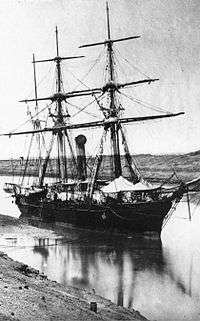French aviso Latouche-Tréville
The Latouche-Tréville was a wooden-hulled steam sloop aviso of the French Navy, a sistership to the D'Estaing. They were designed by Louis Dutard for both service on foreign stations and for various duties in home waters (including fishery protection).
 Portrait of Latouche-Tréville. Photp by Marius Bar | |
| History | |
|---|---|
| Name: | Latouche-Tréville |
| Namesake: | Louis-René Levassor de Latouche Tréville |
| Ordered: | 3 August 1857 |
| Builder: | Toulon Dockyard |
| Laid down: | June 1858 |
| Launched: | 16 February 1860 |
| Completed: | May 1860 |
| Commissioned: | 7 May 1860 |
| Out of service: | Stricken 5 June 1886. |
| Stricken: | 5 June 1886 |
| General characteristics | |
| Class and type: | Steamer aviso |
| Displacement: | 695 tonnes (684 long tons) |
| Length: | 53 m (174 ft) waterline |
| Beam: | 8.32 m (27.3 ft) |
| Draught: | 3.76 m (12.3 ft) |
| Propulsion: | steam engine, 150 hp (110 kW) |
| Complement: | 65 men in 1860, 88 from 1879 |
| Armament: |
|
Career
After her commissioning, Latouche-Tréville sailed to Tahiti, where she was assigned to the French naval station of the Pacific Ocean. She returned to Brest on the 27 January 1868 to be decommissioned on 23 February 1867.
She was recommissioned on the 4 October 1868, and served off Terre-Neuve until 15 October 1870, when she was again decommissioned.
On 15 April 1873, she began her third commission for service in the South Atlantic. In September 1881, she took part in operations off Tunisia.
Fate
Latouche-Tréville was struck on 5 June 1886.
References
- Dictionnaire des bâtiments de la flotte de guerre française de Colbert à nos jours, Tome II, 1870–2006, LV Jean-Michel Roche, Imp. Rezotel-Maury Millau, 2005.
- French Warships in the Age of Sail 1786-1861: Design, Construction, Careers and Fates. Rif Winfield & Stephen Roberts. Seaforth Publishing, 2015. ISBN 978-1-84832-204-2.